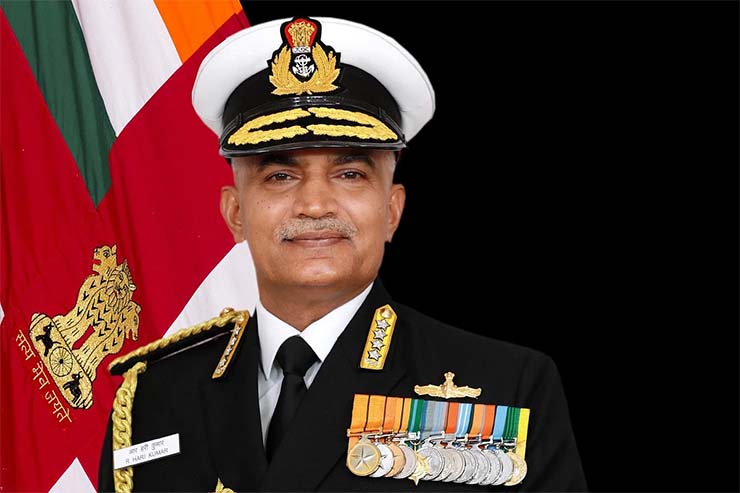
Following a long-term perspective plan, Bharatiya Nausena’s modernisation and expansion is focused on being a future-ready force, with the capability and capacity to meet evolving challenges.
Chief of Naval Staff, Admiral R Hari Kumar in an email interview with Raksha Anirveda, provided a detailed account of Bharatiya Nausena’s commendable strides with its pioneering work towards realising Aatmanirbharta, its emergence as a Combat Ready, Credible, Cohesive and Future Proof naval force, Nausena’s preparedness to effectively tackle the emerging security challenges in view of the ongoing flux in the geopolitical situation and its endeavours to leapfrog the technological curve. Edited excerpts.
RA. Reflecting on the past two years as Navy Chief, kindly provide in detail the major accomplishments of Bharatiya Nausena towards realising its goal of becoming the Net Security Provider, First Responder and Blue Water Navy?
Admiral RHK. As far as rating Bharatiya Nausena’s (Indian Navy) performance for the past two years is concerned, I would just say that the Navy, as the primary manifestation of India’s maritime power, stands ready to fulfill its mandate to protect our national interests in the maritime domain. The Indian Navy (IN) recognises its responsibility in the Region and would continue to be the pillar around which a combined ‘Force for Good’ could be built.
We aim to be the Preferred Security Partner, based on a shared goal of enhancing region’s maritime security quotient. In this endeavour, the Navy’s persistent presence and preparedness across our areas of interest, has remained a critical enabler in addressing shared security challenges.
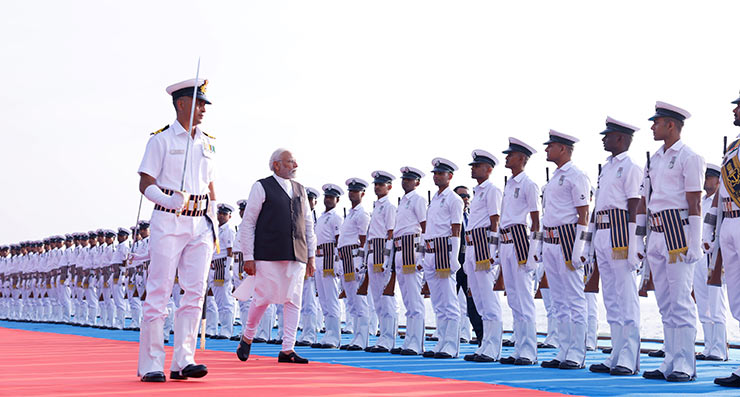
Our ‘Mission Based Deployment’ enhanced the Navy’s presence across the Region, as in the past two years, our ships clocked over 17,000 days at sea. Similarly, our Submarines were deployed extensively for over 1,800 cumulative days, and our aircraft collectively flew more than 26,000 hours. We have been undertaking anti-piracy patrol in the Gulf of Aden since 2008 – and have built valuable relationships with other friendly maritime forces engaged in such operations. So far, 106 Indian Naval ships have safely escorted more than 3,440 Merchant ships of different nationalities. Further, during the last year itself, we undertook four Coordinated Patrols, six EEZ Surveillance for Island Nations in the Region and 22 bilateral/ multi-lateral exercises – all of which have strengthened our stature as the Preferred Security Partner.
Bharatiya Nausena has also remained at the forefront in providing assistance over a wide spectrum of situations, including those related to natural disasters, medical emergencies, critical technical situations, and incident responses, among numerous others. For instance, over the last two years, we rescued a Seychellois citizen from drug dealers; conducted numerous MEDEVACs; assisted a vessel on fire off the Sri Lanka Coast; and provided technical assistance to an adrift motor vessel in the Gulf of Oman. These are just an indication of the array of operations that our deployed units undertake, contributing to being the First Responder.
The US Department of Defence (DoD) and the Indian Ministry of Defence (MoD) launched the India-US Defence Acceleration Ecosystem (INDUS-X) to expand the strategic technology partnership and defence industrial cooperation between both governments, businesses and academic institutions. This initiative aims to build ‘Innovation Bridge’ to connect US and Indian defence Start-ups as part of the US-India initiative on Critical and Emerging Technology (iCET).
Coming to being a Blue Water Navy. I must say that we achieved this status decades ago. Commissioning of the first Indigenous Aircraft Carrier Vikrant, gifting of a fully operational corvette to Vietnam, Swavlamban Seminar, indigenous Scorpene Class submarines and many such endeavours, are reflective of our credibility – both internally as well as externally. We have ensured that our platforms, individually as well as collectively, remain capable of taking the battle to the enemy – in whatever form they may be. Our sustained Mission Based Deployments, across the vast ocean spaces, enable us to tackle any contingency – be it domestic or international – with alacrity and reliability.
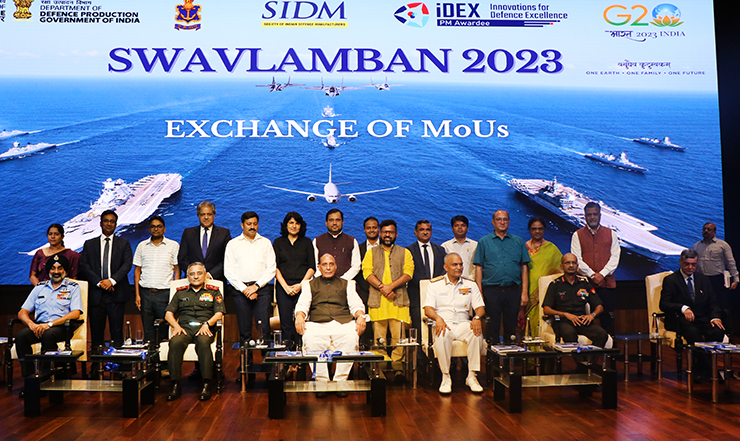
RA. Can you share your perspective on the significance of the ‘Swavlamban 2.0’ seminar for the Bharatiya Nausena, the leap between two editions of Swavlamban, the outcome of SPRINT initiative and how it aligns with the broader indigenisation objectives through collaborative approach between all stakeholders?
Admiral RHK. The maiden NIIO seminar ‘Swavlamban 2022’ provided a platform for taking on challenges in Niche technologies and innovation. IN was the first mover in taking on the challenge of development of technology/ solution/ prototype/ a product on a co-partnership and fast track basis with the assistance of indigenous start-ups/ MSMEs. The occasion was graced by Hon’ble PM and unveiled 75 Challenges for start-ups/ industry with an aim to develop products in a time bound manner.
The 2nd Edition ‘Swavlamban 2023’ with expanded scope provided an enhancement to the maiden seminar for start-ups/ MSMEs, wherein a concurrent ‘Exhibition’ and Display of the indigenous technologies under fast-track development were displayed & showcased to a wider audience from industry/ academia/ DAs from FFCs countries/ Schools at G20 venue, Bharat Mandapam. The traction of the initiative has now facilitated a wider dissemination of information. A few advantage/ positive outcomes are as follows: –
- Visibility of indigenous start-ups/ MSMEs as part of Aatmanirbharta/ national level self-reliance initiative in the Defence sector.
- Familiarisation with the new model of DISC (Defence India Startup challenges) & OC (Open Challenges), series initiated 2018 onwards under the aegies of MoD/DDP through Defence Innovation Organisation (DIO).
- Development & further stabilisation of this co-partnership model based on individual services end-user requirements.
- Familiarisation with Chapter III, Innovation & IDEX route procedures towards ease of business eliminating many of the existing bureaucratic process requirements for all stakeholders which deal with cases at the budgeting, auditing & user end.
- A key outcome is finally to involve all stakeholders towards identifying niche areas and filling deficiencies by using this low-cost, Co-partnership, fast-track model of product development through iDEX / DIO route provided under ‘Amended Acquisition Procedure (DAP-2020).
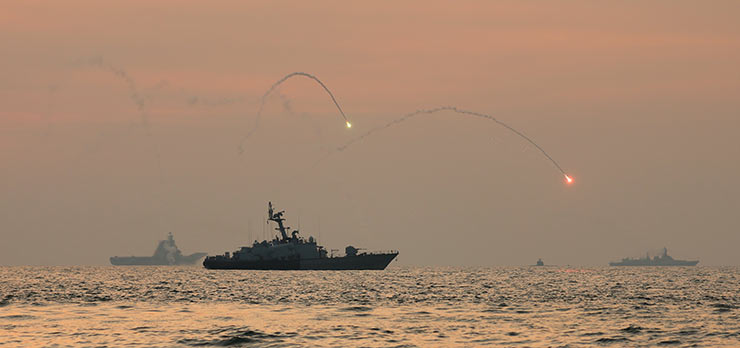
RA. The INDUS X Challenges mark an important Indo-US collaboration. Can you shed light on the significance of these challenges from a naval perspective while continuing its journey towards self-reliance and defence innovation?
Admiral RHK. The US Department of Defence (DoD) and the Indian Ministry of Defence (MoD) launched the India-US Defence Acceleration Ecosystem (INDUS-X) to expand the strategic technology partnership and defence industrial cooperation between both governments, businesses and academic institutions. This initiative aims to build ‘Innovation Bridge’ to connect US and Indian defence Start-ups as part of the US-India initiative on Critical and Emerging Technology (iCET).
Indian Navy had proposed a challenge, viz. ‘Development of Undersea Communication’ to be taken up for joint development with US/ DoD. The said proposal has been launched under INDUS-X category of iDEX Scheme during Navy Seminar, ‘Swavlamban -2023’ on October 4, 2023.
As far as maintaining traditional naval capabilities and integrating new innovations is concerned, Bharatiya Nausena’s modernisation and expansion follows a long-term perspective plan, focused on being a future-ready force, with the capability and capacity to meet evolving challenges. We currently have 67 ships and submarines under construction, with Indian shipyards building 65 of these, contributing significantly to the Government’s Aatmanirbhar Bharat initiative
RA. What would you identify as the key challenges and opportunities for Bharatiya Nausena in the coming years and how you plan to balance between maintaining traditional naval capabilities and integrating new innovations?
Admiral RHK. Bharatiya Nausena’s responsibilities are vast, ranging from readiness to undertake high-intensity war fighting at one end to rendering humanitarian assistance and disaster relief at the other end. We fulfill these responsibilities through four distinct roles – Military, Diplomatic, Constabulary and Benign.
Our primary responsibility is to protect, promote and preserve India’s national interests in the maritime domain. In that context, threats and challenges to our interests emanate from traditional as well as non-traditional sources.
Traditionally, while a war with potential adversaries can never be ruled out, we also face security challenges across multiple spheres. Competition at sea is being played out daily, without escalating into armed action. Lingering traditional security friction points such as the unresolved disputes, are exacerbated by the ongoing Great Power Competition in the Region, thereby, leading to a possibility of this Competition flaring up into a Conflict.
On the other hand, in recent years, other security threats, like, maritime terrorism, piracy, robbery, Illegal Unreported and Unregulated (IUU) fishing, human/ arms/ drugs trafficking, etc., have also manifested. Similarly, piracy and armed robbery at sea have also flared up in a few regions over the past decade and remain a significant threat to international shipping and seafarers. At the same time, there has also been a higher occurrence of natural disasters over the past decade, necessitating increased deployment of the Bharatiya Nausena for HADR operations.
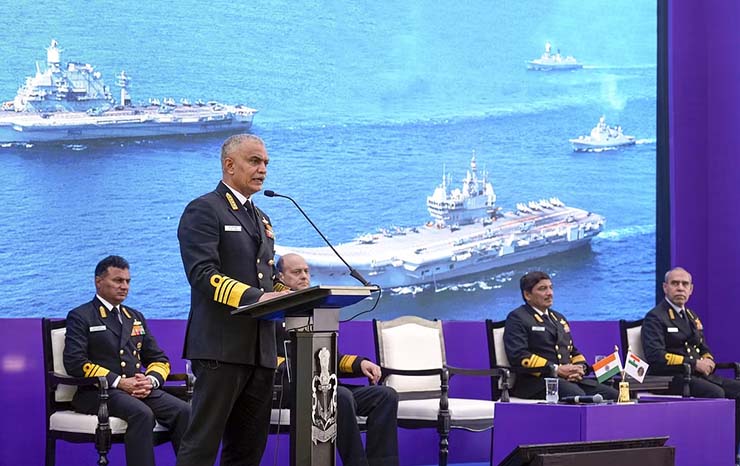
Most of these challenges are fast evolving, transcend national boundaries and are beyond the capacity of any one country to address alone. Therefore, there is a need for coming together based on shared vision and issue-based convergences. The overarching outlook is towards finding regional solutions to regional problems.
As far as maintaining traditional naval capabilities and integrating new innovations is concerned, Bharatiya Nausena’s modernisation and expansion follows a long-term perspective plan, focused on being a future-ready force, with the capability and capacity to meet evolving challenges. We currently have 67 ships and submarines under construction, with Indian shipyards building 65 of these, contributing significantly to the Government’s Aatmanirbhar Bharat initiative.
Bharatiya Nausena (IN) has been at the forefront of Network Centric Operations and has developed a certain degree of proficiency. RPAs or UAVs flown by IN are already fully integrated into the naval network. IN has achieved a high degree of integration of RPAs into naval operations and the ISRO Gaganyaan TV-D1 recovery mission is a recent example
The Bharatiya Nausena is working closely with DRDO and the Indian industry to enhance the technological base in the country. Concurrently, there is also a need to enhance the capacity and expertise of our public sector shipyards to reduce build-times, and also involve the private sector to make good current short-falls in our force levels.
The Bharatiya Nausena endeavours to leapfrog the technology curve rather that tail chasing. We are also well aware of the need to pole-vault in certain niche fields to create technology asymmetry with our potential adversary.
RA. Given the global advancements in UAV technologies, how is the Bharatiya Nausena positioning itself in terms of UAV integration for naval operations? Can you provide technical insights into the systems and platforms that are being inducted, developed or considered for the Manned-Unmanned teaming concept?
Admiral RHK. Bharatiya Nausena (IN) has been at the forefront of Network Centric Operations and has developed a certain degree of proficiency. RPAs or UAVs flown by IN are already fully integrated into the naval network. IN has achieved a high degree of integration of RPAs into naval operations and the ISRO Gaganyaan TV-D1 recovery mission is a recent example.
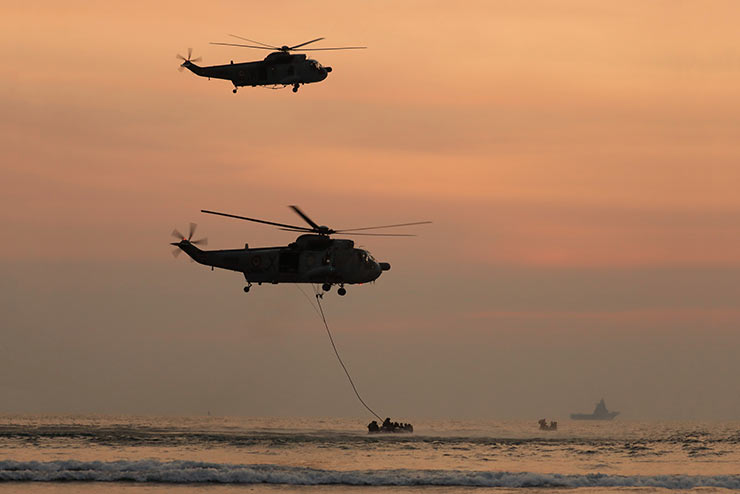
IN is also at the forefront of procuring cutting-edge technologies in the unmanned sphere. A Tri-Services case for procurement of 31 MQ-9B HALE RPAs has been accorded AoN by DAC on June 28, 2023. The RPAs will also be equipped with specific capabilities that allow Manned-Unmanned Teaming (MUM-T). IN is also in the process of integrating Naval Ship-borne Unmanned Aerial Systems (NSUAS) and indigenous drones to operate from ships. Without going into the specifics of the equipment, it would suffice to say that IN would be able to share targeting data from the RPAs to other platforms. This would allow naval units to undertake strike missions from greater stand-off ranges without alerting our adversaries.
Indigenisation is being persistently pursued in the field of Electronic Warfare systems and the replacement of foreign-origin systems. Indigenous EW systems have been developed by DLRL under Programme Samudrika and produced by BEL (Hyderabad). Emerging technologies like Artificial Intelligence, Machine learning and computing on the edge for signal processing are being explored to enable higher computing power and detection capabilities.
RA. Kindly highlight on the advancements Bharatiya Nausena is focusing on in terms of underwater sensors, sonar capabilities, and electronic warfare suites, emerging technologies like quantum sensing, machine learning algorithms influencing the Navy’s sensor development strategy and ensuring interoperability of its platforms with other branches of the armed forces?
Admiral RHK. Bharatiya Nausena is pursuing the development of niche, wide-area underwater surveillance technologies through indigenous sources which include R&D agencies, academia and industry partners. The focus is on advanced hull-mounted sonar systems, towed arrays and persistent underwater surveillance systems. Induction of Towed Array Sonars, remotely operated systems viz. ASV-ASW and ASW-WG for detection of manned and unmanned submersibles are part of the revitalised approach to emerging maritime operations and these inductions are envisaged to provide IN a technological edge over the adversary in underwater domain.
Indigenisation is being persistently pursued in the field of Electronic Warfare systems and the replacement of foreign-origin systems. Indigenous EW systems have been developed by DLRL under Programme Samudrika and produced by BEL (Hyderabad). Emerging technologies like Artificial Intelligence, Machine learning and computing on the edge for signal processing are being explored to enable higher computing power and detection capabilities.
Some of the emerging technology initiatives undertaken by IN through collaboration with Indian defence industry include the drone-based ES System, Quantum Key Distribution (QKD) and 4G tactical LAN for ships. IN has operationally deployed the Software Defined Radios (SDRs) and a joint waveform is also being developed to enhance interoperability between the combatants of the three services. IN is also in the process of integrating its Common Operational Picture with other services. To ensure interoperability with existing systems of IN and commonality with other services, the involvement of IN’s lead integration agency WESEE and HQIDS towards inter-service applicability is being ensured for a synergised approach.















